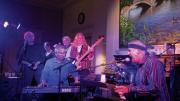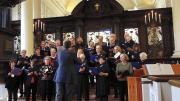Spring reunioners may revel in the celebratory hoopla of Commencement crowds, but alumni gatherings in the fall promise closer, more contemplative conversations. “There is more of a focus on personal connections,” says Anne Holtzworth ’84, M.B.A. ’89, a co-chair of her forthcoming thirtieth reunion in September. She has attended and helped organize every one of her College reunions, yet each time, she says, “I meet new and fascinating people I did not know. As we get older, people are more open and less locked into whatever group they might have been in in college, and the strength of that experience we all shared as young people becomes the foundation for more meaningful adult relationships.”
The decision to shift the thirtieth, fortieth, and forty-fifth reunions from their usual spots during Commencement week to the fall was made by the Harvard Alumni Association (HAA) in the 1990s, according to Michele Blanc, senior associate director of classes and reunions. The reason? “Space constraints,” she reports. “We just could not continue hosting 14 reunion classes at the same time, during Commencement—but we still do the other 11.”
Thus, the classes of 1984, 1974, and 1969 will gather in Cambridge on September 18-21. The long weekend generally opens with evening cocktail receptions on Thursday and ends with brunches on Sunday. At least one of the social events swirls around a Harvard football game (e.g., a tailgate party and optional game attendance), but the reunions also feature symposiums, art and cultural performances, and the traditional memorial service. Last year, the class of 1983 held coed pick-up basketball and soccer games, along with concerts and a slide show of art and books created by classmates. The class of 1968, which boasts the longest-running cabaret show in reunion history, also held a dance featuring the class band, Central Park Zoo.
In recent years, two new features—“Harvard Today: A Faculty Forum” and “Glimpses”—have been added to many reunion programs for both spring and fall. The forums were instituted in the spring of 2013 by the HAA, says Blanc; they include a faculty panel discussion that highlights topics ranging from current research and innovations to advances in teaching and learning. Open to all the reunion classes at the same time, the forum is “a way for alumni to get in touch with what’s happening at the University,” Blanc adds. “They have become a highlight of a reunion.”
“Glimpses,” by contrast, are alumni-driven. A number of pre-selected classmates take three to five minutes each to “share enlightening, inspiring, and amusing personal stories,” in the words of the class of 1983’s fall reunion schedule. Gary Pforzheimer ’84, M.B.A. ’91, one of the organizers of his class’s fall “Glimpses” and other “intellectually stimulating” sessions, says the event is an informal, personal experience. “People are picked out of the Red Book for something interesting about how they have lived the past five years, or how they are doing something that seems fulfilling,” he explains. “They just stand up in front of a mic and tell the class about their lives.”
The fall reunions can differ radically from the more scripted spring gatherings, according to a class’s particular predilections. In part, that’s because even though Commencement offers an exciting culmination to the May reunions, the real work and daily life of the University have wound down for the year. But in the fall, Blanc continues, “Harvard is in full throttle with classes and sports and student art performances. So alumni get a great taste of Harvard life today.”
Some alumni are surprised by the new fall timing—especially the thirtieth reunioners, who have always met in the spring, when Commencement is a natural enticement to return to Cambridge. “It’s also hard,” says Holtzworth, “to go from the peak of the twenty-fifth reunion—subsidized by the HAA, with children’s programming, when everyone brings their families and you’re staying in the Yard, which is a prime location on campus”—to the fall reunions, when alumni stay in local hotels and pay out of pocket for almost everything. “People aren’t that happy, initially,” she adds. “But once they come, past surveys [from other classes] tell us, they are thrilled they did. And of course we can’t stay in the dorms because the students are actually there—which seems fair enough!” (A note on reunion financing: only the twenty-fifth, thirty-fifth, and fiftieth reunions are subsidized by Harvard, although reunioners still pay, on average, $675—plus the costs of any housing—for the twenty-fifth, Blanc says. Fall reunions typically cost each class member $350, plus hotel lodgings, but that includes food, drinks, a reunion souvenir, and any costs involved in holding activities in University facilities. At the memorial services, for example, the sexton and organist, flowers, and printed programs must all be paid for.)
Fall reunions face more complicated logistics, such as finding spaces for meeting sessions and general socializing, says veteran reunion planner Eva Kampits ’68, who co-chaired last year’s group (which atypically met in October). Sharing space with students or planning activities that integrate a sense of academic life on campus, while desirable, can also be tricky, she says, yet “we saw it as a great advantage to be on campus at the same time as the students.” Kampits’s class asked to mingle with students and even to share dining hours at Leverett and Currier Houses on different days, although organizers were careful to ensure that alumni who found the venue too noisy or crowded could eat a bit later than most students, but still sit with classmates. Reunioners also integrated The Opportunes, a student choral group, into their Thursday-evening welcoming events, and had a few students join panelists in the symposiums on higher education.
Kampits and Holtzworth agree on the importance of finding or creating a unifying event to replace Commencement. Many classmates want to attend the Saturday football game, to be among students or to enjoy the nostalgic novelty, but plenty of others want an alternative. Kampits reports that her class organized several informal affinity discussion groups that met during and after a Murr Center luncheon, as the game was shown on the center’s big screens: “The best of both worlds!” she declared. Holtzworth and her co-planners are expanding the focus beyond the game itself, and will “combine it with a cocktail fun party and barbecue at the football field.”
Some of the perceived drawbacks to fall meetings turn out to be benefits. The groups are significantly smaller, for example: instead of the 850 classmates and guests who generally attend a twenty-fifth reunion, somewhere between 200 and 400 generally turn out in September. “They are more intimate gatherings,” Blanc reports, “often because more couples come solo, without partners or kids, because it is a hard time of year for the rest of the family to get away. So this really becomes a time to totally reconnect with classmates.”
Because of that closer contact and qualitative difference in alumni reunions, the class of 1968 held a “single mingle” last fall—not explicitly to foster romantic liaisons, but to share experiences and information about living alone in their later years. “Many of us will likely be single in our seventies, and the meeting was about how to plan your life,” reports Kampits. “People were talking with each other about how you meet social and personal and psychological needs.”
Organizers are adept at creating fun and meaning—most often, simply by mining the rich talents and life experiences of their peers. The class of 1984, for example, was the first to introduce a community- or public-service component to Harvard reunions. Its reunion committee, in discussing what to do for this fall, has reached out to the Phillips Brooks House Association for ideas and possible partnerships. Pforzheimer says he and others are also thinking about holding a “pitch” contest among classmates who work at nonprofits, to raise money and awareness. Last fall the class of 1968, which has happily entertained itself and any guests through its traditional cabaret, for the first time offered an “Open Mic Farewell” that combined a wine bistro atmosphere with music and songs by classmates, as well as a time and space to showcase 10 classmates’ work in various nonprofits.
Reunion committee planners also organized symposiums on climate change, public policy, and the future of healthcare—along with a lively discussion on “Living the ’60s in Our Sixties.” That panel included veteran political activist and organizer Michael Ansara, a leader of the Students for a Democratic Society, former White House correspondent for the Wall Street Journal Ellen Hume (now in Budapest writing a book on journalism and politics), and Dale Gieringer, a director of California NORML, which promotes the campaign to legalize medical marijuana there. Many in attendance celebrated the pot-smoking, political reporting, protests, and general spirit of the times through collective reflections. “I think it’s great,” noted moderator Stephen “Mo” Hanan, an accomplished actor and writer, “that 45 years later…we are still seniors.”














